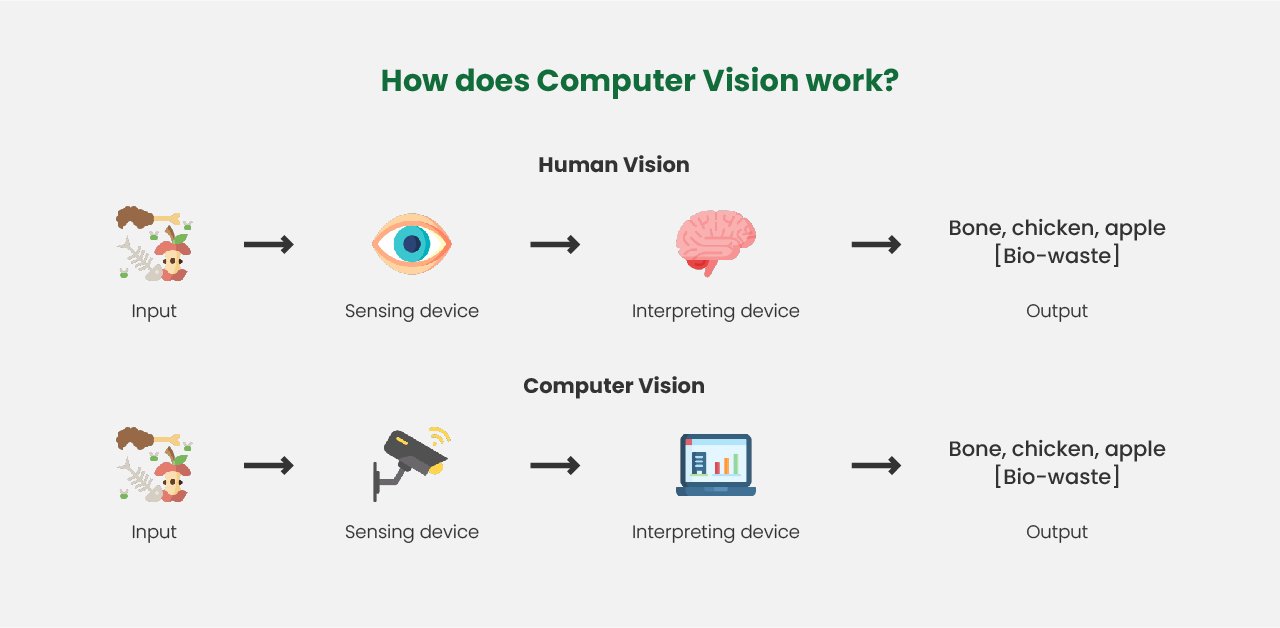Waste Management 2.0: How ‘Computer Vision’ is transforming the industry
In today's rapidly advancing technological landscape, computer vision has emerged as a powerful tool to revolutionise various industries.
One such area where computer vision has the potential to make a significant impact is waste management. By harnessing the capabilities of computer vision, waste management systems can be optimized to enhance efficiency, accuracy, and sustainability.
Understanding the Concept of Computer Vision
Before delving into the ways computer vision can improve waste management, it's crucial to grasp the essence of this innovation. Computer vision, in simple terms, refers to the ability of a computer system to interpret and understand visual data, just like humans do. It involves techniques and algorithms that enable machines to identify, process, and analyse images or videos to extract meaningful insights.
What is Computer Vision?
Computer vision involves the development of algorithms and models that enable computers to interpret and analyse visual data. By using techniques like image segmentation, object detection, and pattern recognition, computers can make sense of images or videos and extract relevant information.
Image segmentation is the process of dividing an image into multiple segments or regions based on certain characteristics. This technique is useful for identifying different objects or areas within an image, allowing computers to understand the context and content of a visual scene.
Object detection, on the other hand, focuses on finding and classifying specific objects within an image or video. By leveraging deep learning models and convolutional neural networks, computers can accurately detect and categorise objects, such as cars, pedestrians, or buildings.
Pattern recognition is another crucial aspect of computer vision. It involves training machines to recognize patterns or specific features in visual data. For example, pattern recognition algorithms can be used to identify faces, detect anomalies in medical images, or classify different types of objects.
The Role of Computer Vision in Technology
Computer vision is an interdisciplinary field with applications in various industries, from healthcare to self-driving cars. This technology enables machines to perceive and understand the visual world, making it an indispensable tool in automation, surveillance, augmented reality, and much more.
In the healthcare sector, computer vision is revolutionising medical imaging. By analysing medical scans and images, computers can assist doctors in diagnosing diseases, detecting tumours, or identifying abnormalities with higher accuracy and efficiency.
In the field of transportation, computer vision plays a crucial role in enabling self-driving cars. By interpreting real-time visual data from cameras and sensors, autonomous vehicles can navigate roads, detect obstacles, and make informed decisions to ensure passenger safety.
Computer vision is also transforming the retail industry. By analysing customer behaviour and preferences through visual data, retailers can personalise shopping experiences, optimise store layouts, and enhance inventory management.
Moreover, computer vision is being used in surveillance systems to enhance security and public safety. By analysing video feeds in real-time, computers can detect suspicious activities, recognize faces, and identify potential threats.
Augmented reality (AR) is another area where computer vision is making significant advancements. By overlaying virtual objects onto the real world, AR applications enhance user experiences in various domains, such as gaming, education, and architecture.
Overall, computer vision is a rapidly evolving field with immense potential. As technology continues to advance, we can expect further breakthroughs in computer vision algorithms and applications, leading to a future where machines can truly "see" and understand the world around us.
The Current State of Waste Management
Before exploring the potential of computer vision in waste management, it's essential to understand the challenges faced by the industry and the traditional methods currently employed.
Modern waste management systems face numerous challenges, including inefficient sorting, excessive waste generation, and inefficient utilisation of human workers in sorting processes. These challenges not only impact the efficiency and cost-effectiveness of waste management but also pose environmental and health risks.
Inefficient sorting is a significant challenge in waste management. With increasing amounts of waste being generated, it becomes crucial to sort and categorise different types of waste accurately. However, manual sorting, the traditional method employed, is time-consuming and prone to errors. This leads to improper disposal and recycling, contributing to environmental pollution and resource wastage.
Excessive waste generation is another pressing challenge faced by waste management systems. As population and consumption patterns continue to grow, the amount of waste produced increases exponentially. This puts a strain on existing waste management infrastructure and necessitates the development of innovative solutions to handle the rising waste volumes effectively.
Lack of data also affects worker-intensive processes because without the right information, humans are deployed haphazardly on the sorting line instead of a planned approach which would maximise the efficiency of the available workforce and reduce potential health risks for workers.
Now, imagine a waste management system that can leverage the power of computer vision to overcome these limitations. Through intelligent image processing and analysis, computer vision can greatly enhance waste management practices, and the data generated from implementing it creates a foundation that will help in the eventual move towards robotics in the sorting processes.
How Computer Vision Can Enhance Waste Sorting
Computer vision can automate and streamline waste sorting processes by accurately identifying and categorising different types of waste. By using image recognition algorithms, waste management systems can detect and classify materials such as paper, plastic, glass, and metal, enabling efficient segregation and recycling.
Imagine a waste sorting facility equipped with advanced computer vision technology. As waste items pass through a conveyor belt, computer vision algorithms analyse the visual data captured by cameras. These algorithms can quickly identify and categorise each item, determining whether it is recyclable or non-recyclable, and if recyclable, which specific category it belongs to.
Moreover, computer vision can also detect contaminants, ensuring that only clean and recyclable materials are included in the recycling process. This level of precision and accuracy significantly improves waste sorting efficiency, reducing the amount of time and effort required by human workers.
The Benefits of Using Computer Vision in Waste Management
The integration of computer vision in waste management offers several compelling advantages, ranging from increased efficiency to positive environmental impact.
Increased Efficiency and Accuracy
By automating waste sorting processes, computer vision significantly improves operational efficiency and accuracy. The advanced algorithms can process vast amounts of visual data in a fraction of the time it would take for manual sorting. This increased efficiency translates into improved recycling rates and reduced waste disposal costs. These systems empower the work force to operate more effectively and focus on bringing the maximum value out of their operations with the resources at hand.
Environmental Impact and Sustainability
Computer vision-enabled waste management systems contribute to environmental sustainability by promoting better recycling practices. Accurate waste sorting ensures that recyclable materials are properly identified and diverted from landfills, reducing the strain on natural resources and mitigating the environmental impact of waste disposal.
Case Studies of Computer Vision in Waste Management
Several real-world examples have demonstrated the effectiveness of computer vision in waste management. For instance, large waste management companies in Europe are using systems that use computer vision to identify and sort recyclable items from mixed waste streams. This technology not only improves sorting accuracy but also reduces the burden on human workers.
Another notable case study is the implementation of computer vision in waste bin monitoring. By equipping waste bins with smart cameras and computer vision algorithms, waste management companies can monitor the fill levels of bins in real-time. This data enables them to optimise waste collection routes, reducing fuel consumption and carbon emissions.
Furthermore, computer vision can aid in the detection of illegal dumping. By analysing images captured by surveillance cameras, computer vision algorithms can identify unauthorised waste disposal activities and alert authorities. This proactive approach helps maintain the cleanliness of our environment and promotes responsible waste management practices.
From automating waste sorting processes to optimising waste collection routes, computer vision enhances efficiency, accuracy, and sustainability in waste management. As technology continues to advance, we can expect further advancements in this field, ultimately leading to a cleaner and more sustainable future.
Implementing Computer Vision in Waste Management Systems
While the benefits of computer vision in waste management are evident, implementing this technology requires careful planning and consideration.
Steps to Incorporate Computer Vision
Integrating computer vision into waste management systems involves several key steps. Firstly, data collection and annotation are essential for building robust models that can accurately identify different waste materials. The development and training of image recognition algorithms specific to waste sorting is the next crucial step. Finally, deploying computer vision-enabled waste sorting systems and ensuring their seamless integration into existing infrastructure is vital for successful implementation.
Potential Challenges and Solutions
As with any technological advancement, implementing computer vision in waste management is not without challenges. These may include initial setup costs, resistance to change, and the need for specialised expertise. However, with proper planning, stakeholder engagement, and long-term cost-benefit analysis, these challenges can be overcome to unlock the full potential of computer vision in waste management.
By harnessing the power of image recognition algorithms and intelligent analysis, waste management systems can become more efficient, accurate, and sustainable. With the potential to optimise waste sorting processes and maximise recycling rates, computer vision is poised to revolutionise the way we manage and reduce waste in the future.
At Trashify, we use our AI-powered computer-vision system to optimise waste management operations, regardless of the level of technology at play in a facility.
To learn more, contact us.


